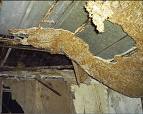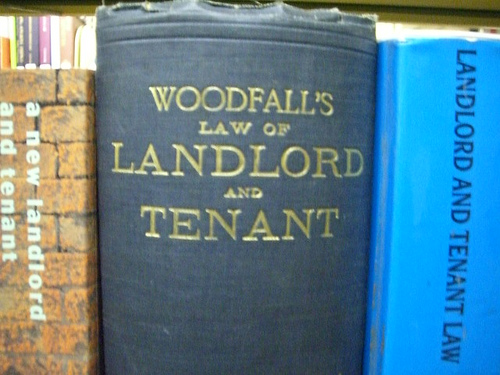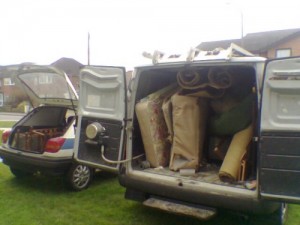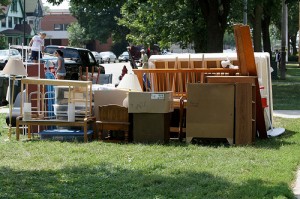Posted by Teresa on October 16, 2009 under Landlord Paperwork and Forms, Landlord Tips | 
 Landlords are legally required to provide tenants with habitable living space. That means you provide working heating, water, plumbing and electrical systems, a roof that doesn’t leak, floors that aren’t rotten, and common areas that are safe for everyone.
Landlords are legally required to provide tenants with habitable living space. That means you provide working heating, water, plumbing and electrical systems, a roof that doesn’t leak, floors that aren’t rotten, and common areas that are safe for everyone.
These are the obvious factors. Depending on where you live, hidden dangers could be lurking in your rental property, threatening your tenants and costing you money to repair. Here are some environmental health hazards every landlord should know about:
Radon: This colorless, odorless, tasteless gas is a major cause of lung cancer. The EPA estimates radon contributes to 21,000 lung cancer deaths per year in the U.S. (2nd only to smoking). Radon occurs naturally in the soil, and can seep into houses—and stay there if the house is highly insulated or poorly ventilated. Landlords are not required to test for radon, but if your property is in an area with historically high levels of radon, you should consider it. Ask your local housing authority for more information.
Mold: Molds are everywhere, and some people are sensitive to even small amounts of airborne mold spores. But when they accumulate in large quantities, molds can cause allergic reactions and respiratory problems—or even neurological problems and death. Wet conditions, from floods, humidity, plumbing leaks, or rainfall, can cause mold to grow. That’s why it’s important to inspect your rental properties often, and to repair or replace water-damaged floors, ceilings, and walls immediately. Educate your tenants about the hazards of allowing water to gather in bathrooms and kitchens, and remind them to report mold or mildew immediately. Keeping the lines of communication open with your tenants can keep everyone safer.
Asbestos: Asbestos is a harmful substance used in building materials such as insulation, tiles, and vinyl flooring, prior to 1981. OSHA requires owners of rental properties built before then to notify contractors and maintenance workers that asbestos may be present. Owners of these older homes should consider having them professionally tested for asbestos. Check OSHA’s website for more information.
Lead: Lead-based paint can be a real problem for owners of older properties. Although banned in 1978, it could still present in older rental units. The paint itself is not a health hazard until it cracks, peels, or turns to chalk with age. And sanding or scraping it releases lead dust, which is a serious health hazard, especially to young children. Federal law requires rental property owners to disclose any known presence of lead-based paint and provide all tenants with copies of records pertaining to the presence of lead-based paint.
CO: Carbon monoxide (CO) is a toxic gas produced by incomplete combustion of fossil fuels: oil, natural gas, wood, coal, and gasoline. In homes, the major sources of CO are fossil fuel burning furnaces, boilers, water heaters and fireplaces. Every year, carbon monoxide poisoning kills 500 people. Most could have been saved with a properly working carbon monoxide detector. If you are a landlord, your state may require carbon monoxide detectors to be installed and maintained in your rental units. But keeping your tenants safe is the right thing to do, whether or not you are required by law to install detectors.
Remember, you are within your rights when
screening tenants prior to leasing. For more landlord resources, including forms and information on
tenant screening, turn to
E-Renter.com. You’ll know that you have the best possible tenants when you
prescreen tenants.
Posted by Teresa on October 9, 2009 under Landlord Paperwork and Forms, Landlord Tips | 
 Rental property lease information is everywhere—on the Internet, in books and newsletters, and given freely by your fellow landlords. And usually, all that advice covers the basics: when the rent is due, the length of the term, utilities that are or are not included, and whether or not pets are allowed.
Rental property lease information is everywhere—on the Internet, in books and newsletters, and given freely by your fellow landlords. And usually, all that advice covers the basics: when the rent is due, the length of the term, utilities that are or are not included, and whether or not pets are allowed.
Experienced landlords know that renting dozens of units to hundreds of tenants over the years will bring to light issues you might not have ever considered adding to your lease. If something you don’t want tenants to do is not specifically prohibited in the lease, a tenant is going to do it. Conversely, if you think every tenant is going to treat your property well just because you expect them to, think again: if it’s not required in the lease, not everyone will do it.
Here are ten items you may not think you need in your lease—but sooner or later, you may change your mind!
Military Clause: You should have some language covering both parties if your tenant is active duty military and receives orders to report to another location.
Vehicles: Not only should you designate where tenants may park their cars, but you need to state clearly where they may NOT park. Otherwise, you could have vehicles on the lawn, on the sidewalk, or in another tenant’s parking spot. Consider also stating that abandoned or non-titled vehicles may not reside on your property, and that any vehicles that are leaking must be parked elsewhere.
Damages: Require new tenants to conduct move-in inspections themselves, and list any and all damage they see on move-in day. Once they sign and date the list, they are agreeing that anything you find upon move-out happened under their tenancy—and is their responsibility.
Garbage: State that the tenant will be responsible for any damage to the garbage disposal, if provided, if caused by bones, grease or any other prohibited item. Believe it or not, you should also spell out that garbage cannot be left in common areas, patios, porches, steps, hallways, etc. and that it must be placed in provided receptacles.
Appliances: Include a clause that tenants may not install or remove any appliance without your written permission and supervision. More than one landlord has a story to tell of improperly installed air conditioning or heating units that caused electrical damage or fires.
Waterbeds: You might think they went away in the 1970s, but waterbeds are still with us. Include a clause that you either do not allow them in your rental units or that tenants who have any liquid-filled furniture carry insurance to cover damages caused by their failure.
Rental Insurance: Spell out clearly that as landlord, you do not hold insurance to cover tenants’ property, and that they should obtain a policy to cover losses that may be incurred as a result of fire, theft, hurricane, etc.
Improvements: Notify your tenant that they must have your permission prior to making any improvements to the interior or exterior of your building, and that these improvements become your property when the lease is over. This includes interior improvements like built-in bookcases, paint and wallpaper, ceiling fans, and light fixtures; exterior items include shrubs, flowers, and other landscaping.
Landscaping: Speaking of shrubs and flowers, include a clause that tenants may not remove, trim, or prune any trees, shrubs, or flowers on the property. If tenants are allowed to weed flower beds, or are responsible for cutting grass, state it here. Many landlords agree that it’s better to hire professionals for lawn care than leave it for tenants!
Locks: Include a clause that tenants may not change the window or door locks.
Posted by Teresa on September 18, 2009 under Landlord Paperwork and Forms, Landlord Tips | 
 The relationship between landlord and tenant should be strictly a business one. Landlords must abide by a variety of federal, state, and local laws designed to protect tenants. Breaking a law, even unintentionally, can spell big trouble to a landlord. And rental property is too valuable to allow tenants to occupy it without the full protection of a legally binding agreement. It’s a mistake to let property without a proper rental agreement or lease. To do so opens a landlord to a great deal of risk, possible financial loss, and even litigation.
The relationship between landlord and tenant should be strictly a business one. Landlords must abide by a variety of federal, state, and local laws designed to protect tenants. Breaking a law, even unintentionally, can spell big trouble to a landlord. And rental property is too valuable to allow tenants to occupy it without the full protection of a legally binding agreement. It’s a mistake to let property without a proper rental agreement or lease. To do so opens a landlord to a great deal of risk, possible financial loss, and even litigation.
Lease or Rental Agreement?
A rental agreement allows a tenant to occupy property for a short period, often 30 days. And, it allows the landlord to increase the rent, change the terms, or terminate it altogether with a short written notice (usually 30 days, but that depends on each state’s laws). This type of agreement renews automatically at the end of the 30 days, unless the tenant or landlord gives written notice that it will end. This is a typical month-to-month type of rental situation.
A lease obligates both parties to a set of conditions and terms for a set period of time, usually one year. During the term of the lease, the landlord cannot raise the rent, and the tenant cannot move out, unless each party operates within terms of the lease that cover these areas. Landlords cannot ask tenants to move out until the lease expires. Either party can decide to not renew the lease with proper notification. Breach of the lease terms can result in eviction of the tenant by the landlord, or litigation between the parties.
Typically, the lease covers areas such as rent amount, term, rent due date, parking regulations, property care and maintenance, landlord entrance, pet policy, and other legal matters.
Rental agreements are more common in areas with high turnover, or where rents are increasing and rentals are in short supply. Leases are preferred by landlords where vacancy rates are higher or where tenants are harder to find.
Whether you decide to use a rental agreement or lease, the important thing is to make certain you are fully protected under a solid and binding legal document.
Remember, you are within your rights when
screening tenants prior to leasing. For more landlord resources, including forms and information on
tenant screening, turn to
E-Renter.com. You’ll know that you have the best possible tenants when you
prescreen tenants.
Posted by Teresa on August 18, 2009 under Landlord Paperwork and Forms, Landlord Tips | 
 It’s vital to have a move-in checklist for each of your rental properties. It’s even more important to personally conduct a pre-move-in walk through with each new tenant. Do this before the tenant moves in!
It’s vital to have a move-in checklist for each of your rental properties. It’s even more important to personally conduct a pre-move-in walk through with each new tenant. Do this before the tenant moves in!
Your move-in checklist documents the condition of each room, along with its contents. When the tenant moves out, you’ll want to conduct another walk through to compare the condition and contents of each room with the move-in checklist. Then, you can determine any damages that the security deposit will cover.
Here’s what you should include on the move-in checklist:
Kitchen
- Condition of floors, walls, ceiling
- Number, condition, and description of light fixtures
- Number, condition, and description of plumbing fixtures
- Number, condition, description, and serial numbers of appliances
- Condition and description of sink
- Stove: number, condition, and description of racks, burners, broilers, hood
- Number and description of ice trays or condition of icemaker
- Condition and description of cabinets, drawers, knobs
- Condition and description of countertops
- Condition and description of doors, doorknobs, hinges, windows, windowsills, locks
Living Room, Dining Room, Bedrooms
- Condition and description of floors, walls, ceiling
- Number, condition, and description of light fixtures
- Condition and description of doors, closet doors, closet interiors, doorknobs, hinges, windows, windowsills, locks
- Condition and Description of thermostat
Bathrooms
- Condition of floors, walls, tub surround, ceiling
- Number, condition, and description of light fixtures
- Number, condition, and description of built-in fixtures: towel racks, soap holders, etc.
- Number, condition, and description of plumbing fixtures: faucet, toilet, sink
- Condition and description of tub and/or shower and caulking
- Condition and description of cabinets, drawers, knobs
- Condition and description of countertops
- Condition and description of closets, doors, doorknobs, hinges, windows, windowsills, locks
On each item, note any scratches, dents, stains, or malfunctioning components. Take photos of every room and everything in it. Note how many keys the tenant received.
And most important: both the landlord and the tenant need to initial each item and sign and date the bottom of the form. This is for the tenant’s protection, as well we yours. When move-out day comes, you’ll both have thorough documentation of each room and everything in it—which will facilitate the return of the security deposit.
Posted by Teresa on June 12, 2009 under Landlord Paperwork and Forms, Landlord Tenant Lawsuits | 
 Lead-based paint can be a real problem for owners of older properties. Although lead in paint was banned in 1978, it could still present in older rental units. The paint itself is not a health hazard until it cracks, peels, or turns to chalk with age. And sanding or scraping it releases lead dust, which is a serious health hazard, especially to young children.
Lead-based paint can be a real problem for owners of older properties. Although lead in paint was banned in 1978, it could still present in older rental units. The paint itself is not a health hazard until it cracks, peels, or turns to chalk with age. And sanding or scraping it releases lead dust, which is a serious health hazard, especially to young children.
As a rental property owner, you should be aware of lead paint dangers and required disclosures. Most states have lead hazard reduction laws in place; some require testing and careful maintenance.
The federal Residential Lead-Based Paint Hazard Reduction Act of 1992 covers dwellings built before lead paint was banned in 1978 and requires rental housing owners or their property managers to notify tenants that the property may have lead-based paint.
Under the federal law, property owners are not currently required to test for lead-based paint or to remove it; but you must disclose any known presence of lead-based paint and provide all tenants with copies of records pertaining to the presence of lead-based paint.
Landlords are also required to provide an information brochure prepared by the federal Environmental Protection Agency (EPA): “Protect Your Family from Lead in Your Home.” This brochure is available online or you can request printed brochures from the National Lead Information Clearinghouse at 800-424-5323.
Certain other dwellings are exempted from the federal law:
- Housing for the elderly or persons with disabilities (unless there are children under age 6 living in the house)
- Short-term (100 days or less) rentals
- Certain university housing
- Studio or efficiency units
- Housing that has been inspected and certified “lead free”
You can always contact the EPA or your local health or environmental agencies for information specific to your area. If you are advised your property is exempt, get verification in writing for your records.
Keep a copy of your tenant’s signed disclosure form for three years. You only need to make the disclosure once, even if the tenant renews an existing lease.
If a landlord fails to follow the federal regulations, and a tenant does not receive required EPA or approved state disclosures, the owner or property manager may be subject to serious fines and penalties. The EPA and HUD are enforcing these regulations, so follow the laws and minimize your risk!
Posted by Teresa on April 27, 2009 under Landlord Paperwork and Forms, Landlord Tips | 

Photo Courtesy of flickr
Our last post covered a few tips for making tenant move-out day a little less stress-inducing. Today we’ll cover a couple other helpful procedures you may not be following, and we’ll talk about the elusive definition of “ordinary wear and tear.”
If your experience with the tenant has been positive, maintain a good relationship by offering to provide your soon-to-be-former tenant with a letter of reference. A good recommendation is very helpful, whether they are moving to another rental or buying a home, and your tenant will probably appreciate the offer. They may even do an extra-good cleanup job on your property—and they’ll be sure to tell their friends and family about it. Good publicity is always good to have.
The Move-Out Inspection
It’s best to schedule the final walk-through after the unit is completely vacant, and the tenants have turned in their keys. Then, there is no possibility of additional damage after the official inspection is completed. The tenant should be present. Make sure you work off of the original Check-In Sheet with the tenant’s signature. Compare each item on the checklist with its condition upon move in day. The tenant may claim to have no knowledge of how damage occurred (or that there even was damage); the fact remains that they are responsible.
Once the inspection is completed, inform the tenant that you will have an estimate for the damages in a timely manner. Most tenants are anxious to get their security deposit back; if you indicate the full deposit is in jeopardy, they might offer to do some more cleaning or repair damages. Remember that you are under no obligation to allow this. However, if you know the tenant’s ability and feel they are capable of completing repairs, you may opt to give them a second chance. Keep in mind that a sloppy paint job or improper repair work will cost you more in the long run!
Defining “Ordinary Wear and Tear”
You are entitled to charge tenants for damages beyond ordinary wear and tear. It’s your job to know the difference between “wear and tear” and serious damage that can be deducted from a tenant’s security deposit.
The standard definition of “ordinary wear and tear” in most states is deterioration or damage to the property expected to occur with normal usage. There are no concrete rules, however, so it’s a tricky judgment call in most cases. Here are some examples:
- Smudges on walls and switch plates: Ordinary wear and tear
- Crayon marks on walls: Damage
- A few small tack or nail holes: Ordinary wear and tear
- Numerous nail holes requiring patching and painting: Damage
- Carpet worn thin from use: Ordinary wear and tear
- Carpet stains or bleach spots: Damage
- Dusty or dirty blinds: Ordinary wear and tear
- Bent or missing blinds: Damage
Making Deductions from Security Deposit
First, make sure that your paperwork is accurate, detailed, and thorough. An incomplete list of charges is asking for trouble. Your tenant could decide to challenge the deductions or even instigate court action. Explain how damage is beyond ordinary wear and tear. For example, just listing “Pet Damage, $50” is not adequate. You must provide details, such as cleaning or replacement receipts. Be thorough and avoid the hassle of fighting it out with your tenants. Here are a few guidelines to follow:
- Name each specific item damaged on a separate line.
- Indicate the exact location of the item.
- Detail the damage, including type and extent. Use specific language like minor scratch, excessive staining, five burn holes.
- Detail the repair completed or that the item required replacing.
- Include repair estimates or replacement receipts for each item.
All tenants move out, but following established procedures and keeping communication open can make it a much easier experience for you and your tenants!
For more landlord resources, including everything you need to know about
tenant screening, turn to
E-Renter.com. You’ll know that you have the best possible tenants when you
prescreen tenants.
Posted by Teresa on April 22, 2009 under Landlord Paperwork and Forms, Landlord Tips, Rents and Deposits | 

Photo Courtesy of flickr
Tenants move out. That’s a reality that every landlord and property manager faces. And when working with all types of tenants, it follows that you’ll have all kinds of move-out experiences—some good, some very bad. Here are a few things to look out for, and some procedures you might find helpful.
Preparing for Move-Out Day
You should really have started preparing for move-out day when your tenant moved in. If you were proactively communicating with your tenant from the start, you already completed a Check-In Sheet. Establishing the condition of the unit upon signing the lease, then using the same list to evaluate on move-out day, is a simple way to track any damage and appropriate charges.
Be Consistent
Maintaining clear communication and working from established procedures are two themes we visit often in this blog. If you have standard procedures and forms in place, every interaction with your tenants will be easier on both parties—and will keep you covered from a legal standpoint as well. Remember that you do not want to be seen as discriminating against any tenants, so you must require the same paperwork and notices from all.
Security Deposit Disputes
This is the number one problem in landlord tenant relationships. Many tenants have a fear of not receiving their security deposit back. If you’ve been inspecting the property on a regular basis, then your tenant has had ample opportunity to point out any problems that could affect their deposit. Still, your definition of “ordinary wear and tear” could vary greatly from your tenants’. Be fair, but firm, take reasonable deductions and provide a thorough accounting of the security deposit. Return the balance promptly, and comply with all local laws covering interest and time limits.
Written Notice
If your tenant mentions in passing or calls specifically to inform you they’re moving, let them know you require written notice. Remind them that the rental agreement states this clearly, and that you need to be sure all are in compliance with the lease and with the law. Provide them with a simple Tenant’s Notice to Vacate Rental Unit form, covering the property address, names, dates, reason for moving, and allowing you access to the unit to inspect and show the unit to prospective tenants or repair people. Do not allow the tenant to skip giving you notice in writing—it brings too many possibilities for problems!
Next post: In Tenants Moving Out, Part II, we’ll explore some additional suggested procedures, the Move-Out Inspection, and help define “ordinary wear and tear.”
Posted by Teresa on April 9, 2009 under Landlord Paperwork and Forms | 
 Keeping files in perfect shape is an elusive goal for most of us. But for landlords and property managers, a reliable record-keeping system is a must. If your strengths lie in areas other than document tracking, you may want to consider a property management company, rather than managing income property yourself.
Keeping files in perfect shape is an elusive goal for most of us. But for landlords and property managers, a reliable record-keeping system is a must. If your strengths lie in areas other than document tracking, you may want to consider a property management company, rather than managing income property yourself.
Rental property owners who manage things themselves will benefit from strong record keeping skills. Start with a basic filing system, with separate sections for each rental property you own. Your local office supply store will be full of options, from simple accordion folders, boxes, and plastic tubs, to locking filing cabinets. When you outgrow your simple system, it’s a good idea to invest in fireproof, locking cabinets.
All property ownership documents, such as purchase offers and contracts, appraisals, loan documents, and insurance policies, should be accessible and protected. Store these items separately from the rental paperwork for the property. Keep accurate records of any incidents or claims against your insurance coverage.
Track income and expenses manually, or on spreadsheets. Or consider one of the many financial management or property management software packages available. Software varies in price range and features; check out a few to see which works best for you; or ask around to see what other landlords are using. Reports, correspondence templates, income and expense tracking, and other features may make a software package a good investment for you. But even if you track all your expenses electronically, paper receipts are still required for tax purposes. Keep them in expense folders for each property.
You’ll also want folders for all rental and tenant documentation. These include maintenance records, tenant applications, rental agreements, legal notices, and tenant correspondence. You never know when you’ll need proof of notices, complaints, or maintenance. If you are involved in a court dispute with a tenant, your good record keeping will definitely pay off. You don’t want to be in a situation where it’s your word against your tenant’s!
Rental property records should be maintained for three to five years, depending on the state where you live and/or own property. Property purchase and capital improvement records should be kept for as long as you own the property. Any records pertaining to injuries, evictions, or other legal matters should be maintained indefinitely.
Setting up and maintaining an efficient record-keeping system will pay off again and again. If you find yourself in court with a tenant or in an IRS audit, you’ll be grateful that your records are well organized!
For more landlord resources, including everything you need to know about
tenant screening, turn to
E-Renter.com. You’ll know that you have the best possible tenants when you
prescreen.
Posted by Teresa on January 13, 2009 under Landlord Paperwork and Forms | 
There are many pre-printed lease forms, and they may suit your purposes just fine. It is always acceptable to change certain items on a pre-printed form, as long as all parties who will sign the document also initial those changes.
You can, of course, also choose to create your own lease (although you should check your local laws or contact an attorney for advice). If you do want to create your own, these are some common items to include in a lease:
- names of all parties
- description of the rental property
- term of the lease
- amount of rent and when that rent is due
- all details regarding security deposit
- what happens in the event of default of any party
- if there is a late fee (and in what amount and when it is due)
- is a business allowed on the property
- does disturbing other tenants constitute default of the lease
- duties of both parties with regard to maintenance
- what happens at the end of the lease term
- under what conditions is the landlord allowed to enter the property
- who pays attorney fees in the event of a lawsuit
- are pets allowed (and details)
- what happens if the landlord dies or sells the building during the term of the lease
Posted by Teresa on December 9, 2008 under Landlord Paperwork and Forms | 
If you use a tenant background search or check tenant credit reports as part of your tenant screening process (and you should!), you also need to supply those tenants who do not qualify to rent your property with a letter declining their rental application.
That rental declination letter needs to:
- let them know that you obtained information from a Consumer Reporting Agency (and list the name, address, and telephone of that agency)
- advise them that they have a right to request a copy of their consumer report, free of charge, from that agency within 60 days of the date of the letter
- notify them they have the right to dispute the accuracy or completeness of any item on their report
 Landlords are legally required to provide tenants with habitable living space. That means you provide working heating, water, plumbing and electrical systems, a roof that doesn’t leak, floors that aren’t rotten, and common areas that are safe for everyone.
Landlords are legally required to provide tenants with habitable living space. That means you provide working heating, water, plumbing and electrical systems, a roof that doesn’t leak, floors that aren’t rotten, and common areas that are safe for everyone.



 Lead-based paint
Lead-based paint 

